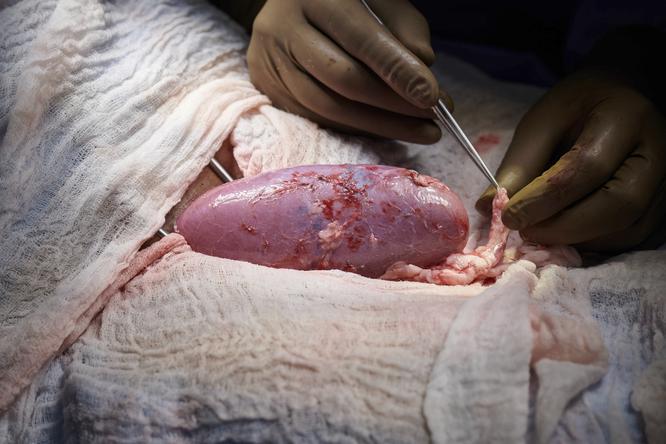Successfully transplanted a pig kidney into a brain-dead woman
A team of American surgeons has successfully transplanted a pig kidney into a brain-dead woman, a medical milestone that brings closer the still distant goal of using animal organs in humans. The kidney, obtained from a genetically modified specimen, functioned correctly for 54 hours, researchers explained to USA Today, the newspaper that revealed the news. The operation took place on September 25 at New York University Langone Medical Center.
The nephrologist Rafael Matesanz, founder of the successful National Transplant Organization of Spain, applauds the new advance. "The experience is fascinating because, at least in the short term, the introduced genetic modification has made it possible to bridge the interspecies barrier, something that has been pursued for decades," he reflects. Matesanz stresses that there are still "many questions" before making the leap to the clinic, such as ruling out the rejection of the porcine organ in the medium term. The expert recalls the case of Stephanie Fae Beauclair, an American girl who in 1984 endured 21 days with a transplanted baboon heart. "In the pig-to-monkey experiments carried out in the 1990s, immediate rejection was avoided, but not a few weeks later," warns Matesanz.
The new operation, led by surgeon Robert Montgomery, implanted the pig's kidney into the woman's left thigh, simply so the organ could be seen and easily monitored. Urine began to flow as soon as human blood flowed through the porcine organ, according to information published in USA Today. The family of the brain-dead woman had previously authorized the trial, considering that she — a donor and friend of people with kidney failure undergoing dialysis — would have loved to participate. Montgomery himself has been living with a donor heart for three years.
The American surgeon has stated that the transplant worked "even better" than he expected. “It looked like any of the living donor transplants I've done. Many kidneys of deceased people do not work right away and take days or weeks to start. This one worked right away,” Montgomery explained to The New York Times. After the operation, the brain-dead woman was disconnected from the life support machine that kept her blood circulating in order to carry out the experiment.

The World Health Organization estimates that around 130,000 transplants are performed each year on the planet, less than 10% of those needed. Spain has been the world leader in donation for three decades, but the drastic reduction in traffic accidents —the traditional source of organs— is also forcing us to look for alternatives. Having animal spare parts would be a solution to this shortage, according to scientists such as the Spanish Juan Carlos Izpisua, although Matesanz stresses that making the leap to the clinic "is not going to be easy", especially for ethical reasons. A patient who needs a kidney can wait on dialysis until a human replacement is available, emphasizes the nephrologist. “Offering a pig kidney to a person is grossly substandard. The ethics committees are going to think about it five times”, argues Matesanz. Surgeon Robert Montgomery has declared that the next step will "probably" be to try to transplant a heart, a vital organ and with a longer waiting list, although there are already artificial hearts that allow time to find a donor.
One of the trickiest minefields to navigate when learning a new language is how to extend, accept, and decline an i… https://t.co/9iRxLHFRMZ
— Italy Magazine Sun Jun 27 13:16:00 +0000 2021
Behind the transplant in New York is the American company Revivicor, established in 2003 from the British company PPL Therapeutics, which in turn was involved in 1996 in the creation of Dolly the sheep, the first mammal cloned from an adult cell. Revivicor modifies a specific gene in pig embryos, called Gal, to produce pigs with organs more compatible with primates, as previous experiments with monkeys had shown. The details of the procedure are pending publication in a scientific journal.
Spanish chemist Marc Güell is one of the co-founders of eGenesis, another American company dedicated to trying to humanize pig organs for transplants. Güell considers that the advance of his competition is "fantastic news" and believes that it was "totally expected that they would be the first". The researcher recalls that the field of xenotransplantation - transplants from one species to another - went through "a very tough time" at the beginning of the 21st century, after several failures. In recent years, however, the revolutionary genetic engineering technique CRISPR, capable of editing genes quickly and cheaply, has accelerated scientific advances. "Now there is a renaissance in pig engineering," celebrates Güell, from Pompeu Fabra University in Barcelona.
The New York operation opens a new phase in a career that has lasted more than half a century. The American surgeon Keith Reemtsma already desperately transplanted chimpanzee kidneys to 13 people between 1963 and 1964. All the patients died, due to rejection or infections, although a 23-year-old professor survived almost nine months. Reemtsma, who died in 2000 at the age of 74, affirmed that xenotransplantation was already present in Greek mythology, with the character of Daedalus, who made bird wings so that he and his son Icarus could escape from the labyrinth of Crete.
That mythological idea is getting closer to becoming a reality, thanks to genetic engineering and cloning techniques, which make it possible to obtain pigs whose organs do not provoke an exacerbated response from the human immune system. In the New York surgery, Montgomery's team also transplanted the kidney next to the thymus, the porcine gland that produces white blood cells, to help prevent rejection. The surgeon affirms that "there did not seem to be any type of incompatibility" between the pig organ and the human body. In his opinion, this is the way to overthrow an old paradigm: that one person has to die for another to live.
You can write to us at manuel@esmateria.com or follow MATERIA on Facebook, Twitter, Instagram or subscribe to our newsletter here.








